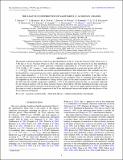THE X-RAY FLUX DISTRIBUTION OF SAGITTARIUS A* AS SEEN BY CHANDRA
Author(s)
Neilsen, Joseph M. G.; Markoff, Sera B.; Nowak, Michael A.; Dexter, J.; Witzel, G.; Barriere, Nicolas M.; Li, Y.; Degenaar, N.; Fragile, P. C.; Gammie, C.; Goldwurm, A.; Grosso, N.; Haggard, D.; Baganoff, Frederick K; ... Show more Show less
DownloadNeilsen-2015-THE X-RAY FLUX DISTR.pdf (715.3Kb)
PUBLISHER_POLICY
Publisher Policy
Article is made available in accordance with the publisher's policy and may be subject to US copyright law. Please refer to the publisher's site for terms of use.
Terms of use
Metadata
Show full item recordAbstract
We present a statistical analysis of the X-ray flux distribution of Sgr A* from the Chandra X-Ray Observatory's 3 Ms Sgr A* X-ray Visionary Project in 2012. Our analysis indicates that the observed X-ray flux distribution can be decomposed into a steady quiescent component, represented by a Poisson process with rate Q = (5.24 ± 0.08) × 10–3 counts s–1, and a variable component, represented by a power law process (dN/dFvpropF –ξ, $\xi =1.92_{-0.02}^{+0.03}$). This slope matches our recently reported distribution of flare luminosities. The variability may also be described by a log-normal process with a median unabsorbed 2-8 keV flux of $1.8^{+0.8}_{-0.6}\times 10^{-14}$ erg s–1 cm–2 and a shape parameter σ = 2.4 ± 0.2, but the power law provides a superior description of the data. In this decomposition of the flux distribution, all of the intrinsic X-ray variability of Sgr A* (spanning at least three orders of magnitude in flux) can be attributed to flaring activity, likely in the inner accretion flow. We confirm that at the faint end, the variable component contributes ~10% of the apparent quiescent flux, as previously indicated by our statistical analysis of X-ray flares in these Chandra observations. Our flux distribution provides a new and important observational constraint on theoretical models of Sgr A*, and we use simple radiation models to explore the extent to which a statistical comparison of the X-ray and infrared can provide insights into the physics of the X-ray emission mechanism.
Date issued
2015-01Department
MIT Kavli Institute for Astrophysics and Space ResearchJournal
Astrophysical Journal
Publisher
Institute of Physics/American Astronomical Society
Citation
Neilsen, J., S. Markoff, M. A. Nowak, J. Dexter, G. Witzel, N. Barrière, Y. Li, et al. “ THE X-RAY FLUX DISTRIBUTION OF SAGITTARIUS A* AS SEEN BY CHANDRA .” The Astrophysical Journal 799, no. 2 (January 29, 2015): 199. © 2015 American Astronomical Society.
Version: Final published version
ISSN
1538-4357